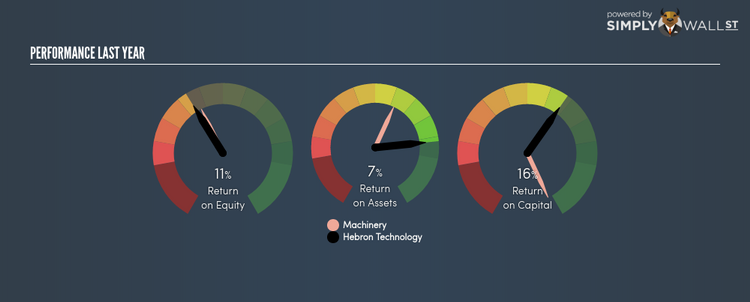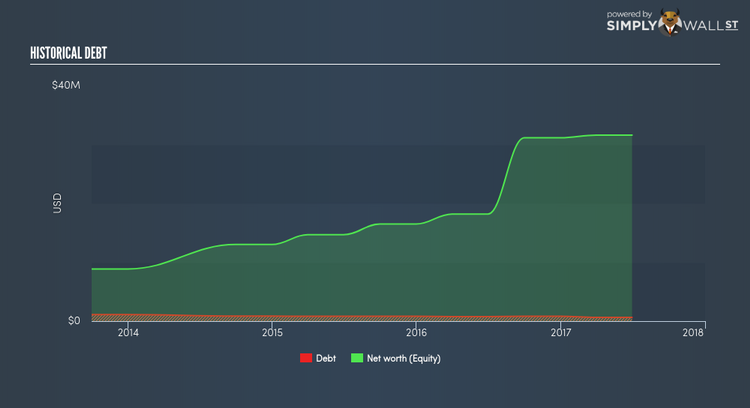Did Hebron Technology Co Ltd. (NASDAQ:HEBT) Create Value For Investors Over The Past Year?

Hebron Technology Co Ltd.’s (NASDAQ:HEBT) most recent return on equity was a substandard 10.91% relative to its industry performance of 11.30% over the past year. Though HEBT’s recent performance is underwhelming, it is useful to understand what ROE is made up of and how it should be interpreted. Knowing these components can change your views on HEBT’s below-average returns. Today I will look at how components such as financial leverage can influence ROE which may impact the sustainability of HEBT’s returns. See our latest analysis for Hebron Technology
Breaking down Return on Equity
Return on Equity (ROE) is a measure of Hebron Technology’s profit relative to its shareholders’ equity. It essentially shows how much the company can generate in earnings given the amount of equity it has raised. Generally speaking, a higher ROE is preferred; however, there are other factors we must also consider before making any conclusions.
Return on Equity = Net Profit ÷ Shareholders Equity
ROE is measured against cost of equity in order to determine the efficiency of Hebron Technology’s equity capital deployed. Its cost of equity is 8.86%. Hebron Technology’s ROE exceeds its cost by 2.04%, which is a big tick. Some of its peers with higher ROE may face a cost which exceeds returns, which is unsustainable and far less desirable than Hebron Technology’s case of positive discrepancy. ROE can be dissected into three distinct ratios: net profit margin, asset turnover, and financial leverage. This is called the Dupont Formula:
Dupont Formula
ROE = profit margin × asset turnover × financial leverage
ROE = (annual net profit ÷ sales) × (sales ÷ assets) × (assets ÷ shareholders’ equity)
ROE = annual net profit ÷ shareholders’ equity
Essentially, profit margin shows how much money the company makes after paying for all its expenses. The other component, asset turnover, illustrates how much revenue Hebron Technology can make from its asset base. And finally, financial leverage is simply how much of assets are funded by equity, which exhibits how sustainable the company’s capital structure is. Since ROE can be inflated by excessive debt, we need to examine Hebron Technology’s debt-to-equity level. Currently the debt-to-equity ratio stands at a low 2.04%, which means Hebron Technology still has headroom to take on more leverage in order to increase profits.
Next Steps:
While ROE is a relatively simple calculation, it can be broken down into different ratios, each telling a different story about the strengths and weaknesses of a company. Although Hebron Technology’s ROE is underwhelming relative to the industry average, its returns are high enough to cover the cost of equity. Also, ROE is not likely to be inflated by excessive debt funding, giving shareholders more conviction in the sustainability of returns, which has headroom to increase further. Although ROE can be a useful metric, it is only a small part of diligent research.
For Hebron Technology, I’ve compiled three key factors you should look at:
1. Financial Health: Does it have a healthy balance sheet? Take a look at our free balance sheet analysis with six simple checks on key factors like leverage and risk.
2. Future Earnings: How does Hebron Technology’s growth rate compare to its peers and the wider market? Dig deeper into the analyst consensus number for the upcoming years by interacting with our free analyst growth expectation chart.
3. Other High-Growth Alternatives : Are there other high-growth stocks you could be holding instead of Hebron Technology? Explore our interactive list of stocks with large growth potential to get an idea of what else is out there you may be missing!
To help readers see pass the short term volatility of the financial market, we aim to bring you a long-term focused research analysis purely driven by fundamental data. Note that our analysis does not factor in the latest price sensitive company announcements.
The author is an independent contributor and at the time of publication had no position in the stocks mentioned.


